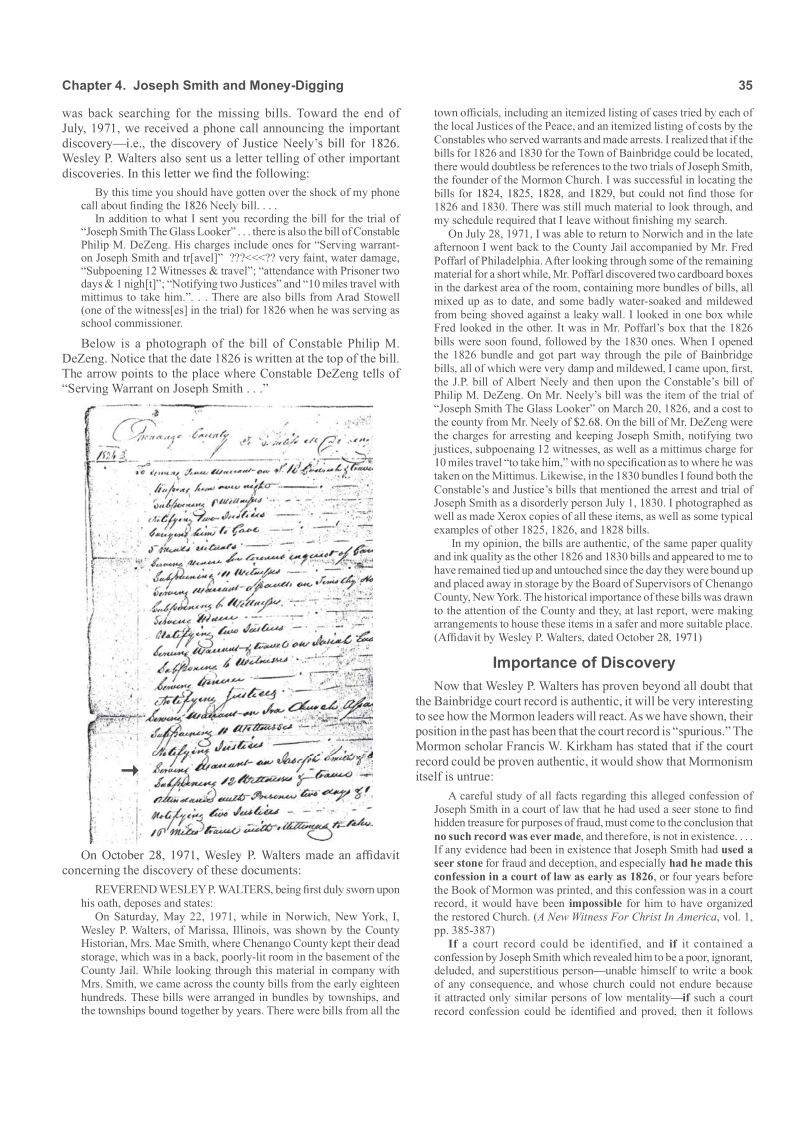Wesley Walters's affidavit concerning his discovery of the 1826 bills; writes that they are authentic.
- Type
- Affidavit
- Source
- Wesley P. Walters CriticNon-LDS
- Hearsay
- DirectReprint
- Reference
Affidavit by Wesley P. Walters, dated October 28, 1971 in Jerald Tanner and Sandra Tanner, Mormonism: Shadow or Reality? 5th ed. (Salt Lake City: Utah Lighthouse Ministry, 1987), 35
- Scribe/Publisher
- Utah Lighthouse Ministry
- People
- Mae Smith, Joseph Smith, Jr., Philip M. De Zeng, Fred Poffarl, Wesley P. Walters, Albert Neely
- Audience
- Reading Public
- Transcription
REVEREND WESLEY P. WALTERS, being first duly sworn upon his oath, deposes and states:
On Saturday, May 22, 1971, while in Norwich, New York, I, Wesley P. Walters, of Marissa, Illinois, was shown by the County Historian, Mrs. Mae Smith, where Chenango County kept their dead storage, which was in a back, poorly-lit room in the basement of the County Jail. While looking through this material in company with Mrs. Smith, we came across the county bills from the early eighteen hundreds. These bills were arranged in bundles by townships, and the townships bound together by years. There were bills from all the town officials, including an itemized listing of cases tried by each of the local Justices of the Peace, and an itemized listing of costs by the Constables who served warrants and made arrests. I realized that if the bills for 1826 and 1830 for the Town of Bainbridge could be located, there would be doubtless be references to the two trials of Joseph Smith, the founder of the Mormon Church. I was successful in locating the bills for 1824, 1825, 1828, and 1829, but could not find those for 1826 and 1830. There was still much material to look through, and my schedule required that I leave without finishing my search.
On July 28, 1971, I was able to return to Norwich and in the late afternoon I went back to the County Jail accompanied by Mr. Fred Poffarl of Philadelphia. After looking through some of the remaining material for a short while, Mr. Poffarl discovered two cardboard boxes in the darkest area of the room, containing more bundles of bills, all mixed up as to date, and some badly water-soaked and mildewed from being shoved against a leaky wall. I looked in one box while Fred looked in the other. It was in Mr. Poffarl’s box that the 1826 bills were soon found, followed by the 1830 ones. When I opened the 1826 bundle and got part way through the pile of Bainbridge bills, all of which were very damp and mildewed, I came upon, first, the J.P. bill of Albert Neely and then upon the Constable’s bill of Philip M. DeZeng. On Mr. Neely’s bill was the item of the trial of “Joseph Smith The Glass Looker” on March 20, 1826, and a cost to the county from Mr. Neely of $2.68. On the bill of Me. DeZeng were the charges for arresting and keeping Joseph Smith, notifying two justices, subpoenaing 12 witnesses, as well as a mittimus charge for 10 miles travel “to take him,” with no specification as to where he was taken on the Mittimus. Likewise, in the 1830 bundles I found both the Constable’s and Justices’s bills that mentioned the arrest and trial of Joseph Smith as a disorderly person July 1, 1830. I photographed as well as made Xerox copies of all these items, as well as some typical examples of other 1825, 1826, and 1828 bills.
In my opinion, the bills are authentic, of the same paper quality and ink quality as the other 1826 and 1830 bills and appeared to me to have remained tied up and untouched since the day they were bound and placed away in storage by the Board of Supervisors of Chenango County, New York. The historical importance of these bills was drawn to the attention of the County and they, at last report, were making arrangements to house these items in a safer and more suitable place.
- Citations in Mormonr Qnas
The B. H. Roberts Foundation is not owned by, operated by, or affiliated with the Church of Jesus Christ of Latter-day Saints.

